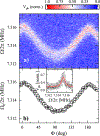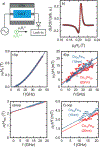Magnetoelasticity of Co25Fe75 thin films
- PMID: 33149369
- PMCID: PMC7607915
Magnetoelasticity of Co25Fe75 thin films
Abstract
We investigate the magnetoelastic properties of Co25Fe75 and Co10Fe90 thin films by measuring the mechanical properties of a doubly clamped string resonator covered with multilayer stacks containing these films. For the magnetostrictive constants, we find λ Co25 Fe75 = (-20.68 ± 0.25) × 10-6 and λ Co10 Fe90 = (-9.80 ± 0.12) × 10-6 at room temperature, in contrast to the positive magnetostriction previously found in bulk CoFe crystals. Co25Fe75 thin films unite low damping and sizable magnetostriction and are thus a prime candidate for micromechanical magnonic applications, such as sensors and hybrid phonon-magnon systems.
Figures






References
-
- Mangin S, Ravelosona D, Katine JA, Carey MJ, Terris BD, and Fullerton EE, “Current-induced magnetization reversal in nanopillars with perpendicular anisotropy,” Nat. Mater 5, 210–215 (2006).
-
- Krause S, Berbil-Bautista L, Herzog G, Bode M, and Wiesendanger R, “Current-induced magnetization switching with a spin-polarized scanning tunneling microscope,” Science 317, 1537–1540 (2007). - PubMed
-
- Yang T, Kimura T, and Otani Y, “Giant spin-accumulation signal and pure spin-current-induced reversible magnetization switching,” Nat. Phys 4, 851–854 (2008).
-
- Miron IM, Garello K, Gaudin G, Zermatten P-J, Costache MV, Auffret S, Bandiera S, Rodmacq B, Schuhl A, and Gambardella P, “Perpendicular switching of a single ferromagnetic layer induced by in-plane current injection,” Nature 476, 189–193 (2011). - PubMed
-
- Liu L, Lee OJ, Gudmundsen TJ, Ralph DC, and Buhrman RA, “Current-induced switching of perpendicularly magnetized magnetic layers using spin torque from the spin Hall effect,” Phys. Rev. Lett 109, 096602 (2012). - PubMed
Grants and funding
LinkOut - more resources
Full Text Sources
